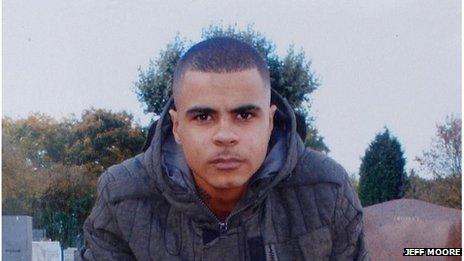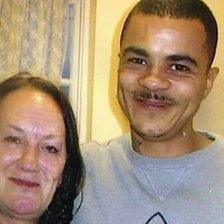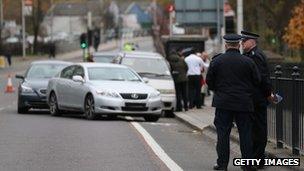Mark Duggan inquest: Why killing was deemed lawful
- Published

Mark Duggan was shot by police in north London in 2011
The jury at the inquest into the death of Mark Duggan has concluded by a majority of eight to two that he was lawfully killed by police. The inquest raised important questions about the way the police carry out firearms operations on the streets of Britain.
Mark Duggan may have been a gangster in possession of a gun, but that alone would not have made his killing by police lawful.
The law and police guidelines say that an officer can only shoot someone if absolutely necessary, and they honestly believe that person was an imminent threat.
Police witnesses say Mr Duggan was such a threat when they killed him. The officer who shot him, V53, and another officer, W70, standing alongside the first, said that when Mr Duggan got out of the cab he reached toward the waistband of his trousers and pulled out a gun.
A third officer standing behind Mr Duggan said he shouted "he's reaching, he's reaching". After V53 fired a first time, he said he "reassessed", Mr Duggan still had the gun, and he shot him again.
However, the inquest had other evidence to consider. The account above was given by police officers. The inquest heard from only one civilian witness to the shooting itself and he gave a very different account.
"Witness B" said he was watching through the open window of a ninth floor flat on the other side of the road. He described what he saw as "an execution".
Gun disappeared
Mr Duggan was not holding a gun, he said, but a mobile phone. He said Mr Duggan tried at first to run away, but was "trapped", appeared "baffled" and was holding his arms up as if to surrender when he was shot by an officer within five to seven steps of him. But Witness B's evidence was not enough to convince the jury.

Mark was described by his mother as shy when he was younger
The inquest was shown police briefings which said Mr Duggan was a senior member of a gang called Tottenham Man Dem, he had previously been arrested on suspicion of attempted murder and possession of guns, and on the day that he was shot he was being followed by police.
They believed he had collected a gun from another man, Kevin Hutchinson-Foster, and the inquest was told that the aim of the operation was to take that gun off the streets.
As soon as Mr Duggan was shot by police the gun apparently disappeared. One officer at the scene said that even as he fell to the ground, and the officer grabbed his arms, the gun was nowhere to be seen.
Nobody said they saw him throw it, either before or after. Officers said they later found the gun, wrapped in a black sock, some 20ft (6m) away on the other side of some railings.
An independent pathologist said that because of Mr Duggan's injuries it was "very unlikely" - but not impossible - that he would have been able to throw the gun such a distance after he had been shot.
During his summing up, the coroner told the jury the conviction of Hutchinson-Foster for supplying the gun was "not determinative" of Mr Duggan having a gun in the minicab, but it was "very strong evidence".
Lawyers for the Duggan family suggested police had "planted" the gun on the grass after the shooting. That was vehemently denied by the police.
In their findings, the inquest jury decided that the police were right to choose the location they used for the "hard stop" - and they decided by a majority of nine to one that Mark Duggan had thrown the gun way from his minicab before he faced police. They concluded by a majority of eight to two that Duggan was lawfully killed.
Crime scene
The Independent Police Complaints Commission (IPCC) was also scrutinised during the inquest. Because of a lack of resources, the IPCC lead investigator - a former police officer of 30 years' experience - explained that the organisation was reliant on police officers to secure the crime scene.

Jurors have visited the scene of the shooting
He admitted he had not known "for some days" that the gun was found 20ft from the shooting and had not been present when the police officers sat in a room together to compose their witness statements.
In the hours that followed the shooting the IPCC was also responsible for making public the most incendiary claim of all - an entirely incorrect suggestion that Mr Duggan had himself fired at police officers.
The IPCC has yet to publish its long-awaited report into the Duggan shooting, but has apologised to his family.
By the time relatives and friends of Mr Duggan arrived to protest at Tottenham police station 48 hours after the shooting, they were angry and suspicious.
They had not been properly notified of Mr Duggan's killing, and had heard conflicting accounts of what had happened. The riots began that night.